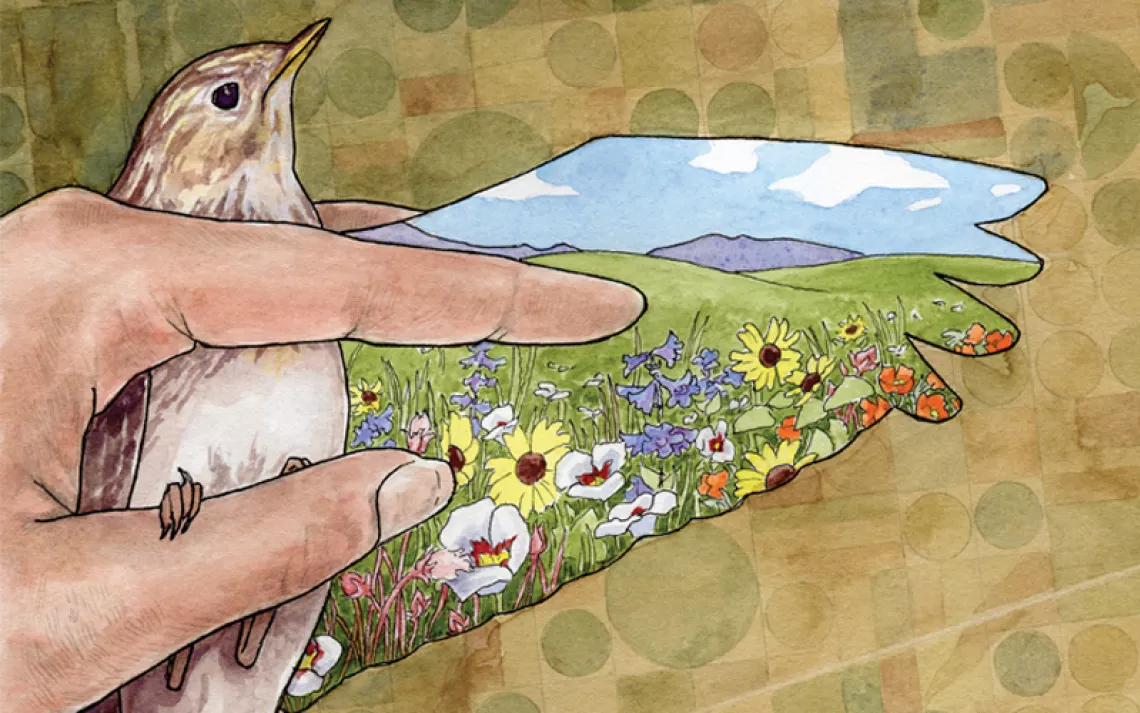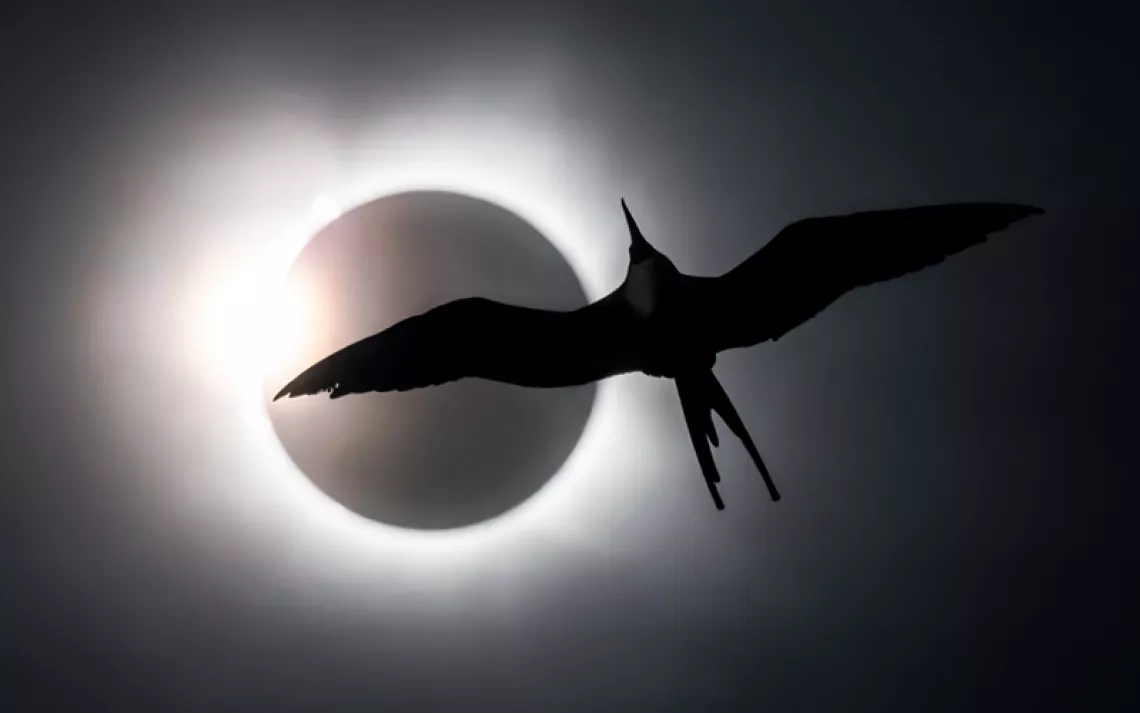Whooping Crane Migration Changes Course
After 15 years of using crane costumes and ultralight aircraft, researchers are taking a more naturalistic approach to restoring crane populations in the eastern United States

Whooping cranes fly with the ultralight. | Photo courtesy of Operation Migration
Normally this time of year, Joe Duff and his partners at Operation Migration are packing their chase vans and checking on their ultralight aircraft. Each fall, for a decade and a half, one of their costumed pilots has led a herd of critically endangered whooping cranes on a months-long odyssey from their nesting habitat in central Wisconsin to their winter home in Florida. The Canada-based nonprofit pioneered the use of the ultralight as a way of establishing an aircraft-led, migratory group of the giant white birds.
But the ultralights are packed away and Duff and his colleagues are still firmly on terra firma. That’s because earlier this year, the Whooping Crane Eastern Partnership, which includes Operation Migration, the International Crane Foundation, U.S. Fish and Wildlife Service, USGS, and the Wisconsin DNR, decided to get rid of the beloved and media-friendly ultralights and changed up other aspects of the epic project to restore the cranes.
“It’s hard. The ultralights are the most visible part of the project, and the public loved them, and Operation Migration was really good at it,” says Peter Fasbender, field office supervisor at the USFWS and co-chair of the partnership.
Fasbender says the changes were necessary because the birds aren’t reproducing in the wild, and researchers think excessive human interaction may be at fault. In the past, caretakers wearing costumes to prevent the birds from getting too comfortable with people have raised the captive-born cranes from birth instead of their parents, and a costumed pilot has led them south in the ultralight. The partnership hopes that getting rid of these artificial methods and letting crane parents raise their chicks will help the birds learn how to live in the wild from the best teachers: other cranes.
“[In] the end, the birds just weren’t doing what we needed them to do,” says Fasbender. “If they are not reproducing, then we’ve all failed. We need a self-sustaining population that can take care of itself.”
Whooping cranes are the tallest bird in North America, standing around five feet tall with a seven-foot wingspan. The bright white birds have a distinct red face and a loud bugling call that can be heard miles away. They stick out on the landscape like Big Bird, and that’s one reason they’re endangered. Unregulated hunting in the early 20th century, as well as the destruction of the deep-water marshes they prefer, reduced the bird’s numbers to just 21 by 1941. Unlike other wetland and coastal birds, like the smaller sandhill crane and great egret, which have recovered from plume hunting and other threats, the whooping crane still struggles. That’s because it can live up to 28 years, doesn’t breed until age three or later, mates for life, and produces only one chick per year. It’s taken almost 75 years for the current population to increase to roughly 600 birds.
About 275 of those birds are considered a “wild” flock that migrates annually from the vicinity of Wood Buffalo National Park in northern Alberta to the Texas coast. But wildlife ecologists worried that having just one flock of birds made the whole population vulnerable to disasters like a bad hurricane, a disease outbreak, or an oil spill. That’s why they decided to add new populations to the mix. Between 1993 and 2004, 289 captive-bred whooping cranes were released in central Florida in the hopes of creating a nonmigratory flock. In 2001, captive cranes were released in promising breeding habitat in the Necedah National Wildlife Refuge in Wisconsin.
That’s when Duff and Operation Migration got involved, training groups of young birds each year to fly behind the ultralight. In the fall, the cranes then tailed the craft and pilot about 1,500 miles to their winter roosts in Florida. The hope was that the cranes would begin breeding in Wisconsin and learn the new migration route to their winter site in Florida, eventually creating a self-sustaining group.
But things haven’t worked out that way. The Florida flock has had trouble reproducing and is now down to 20 birds. The Wisconsin flock, which is replenished each year with captive-raised birds, is steady at about 100. They too are having trouble raising chicks. In the spring and summer of 2016, 23 chicks fledged, but only one survived. Researchers suspect that many of the captive-reared cranes are fine as far as their innate biology is concerned—finding a mate, fertilizing an egg, and hatching a chick. But when it comes to teaching their chicks survival skills and protecting them, they simply don’t know how to parent.
That may be because in captivity, the cranes are taken away from their parents and raised by handlers who wear costumes so the chicks don’t imprint on the parents. Researchers believe the chicks may miss critical behavioral cues by not being around adult birds. Now, for the first time, they are getting rid of the costumes and letting the crane parents rear the birds in facilities in Wisconsin and at the Patuxent Research Refuge in Maryland. This autumn, the young cranes were transported to the vicinity of established wild crane pairs in central Wisconsin that can adopt them and show them how to find food and avoid predators—and eventually, guide them on the migration route to the Sunshine State.
“The costume was a way to raise a lot of birds at once,” says Ann Lacy, the crane research coordinator at the Baraboo, Wisconsin–based International Crane Foundation. “We had to speed up things where we could have a lot of birds on the landscape and had to have that measure of artificiality to get the population jump started. Now contact with humans is minimized, and the chicks see their parents defending their territories and more natural behavior.”
Getting rid of the ultralights was also part of decreasing some of that artificiality. Operation Migration has now retooled to help connect young birds released into the field with the adult birds and monitor their progress.
Duff says he doesn’t necessarily miss the grueling migration flights—last year it took 115 days to get the crane flock to Florida—but he was surprised at the abrupt end to the program. Despite his disappointment, he wants to continue doing what is best for the birds. “We’ve achieved one of our major goals, which was to reintroduce these birds into the eastern states,” he says. “But reproduction isn’t what it should be. Basically, we have to answer the question of whether parent-rearing these birds is the route to go.”
Fasbender says it’s way too early to assess whether the new strategy, which began in September, is working. “It’s not like breeding fruit flies with generation on top of generation,” he says. “This stuff takes time. It will take five years to know if a decision we make works. We have a really bright team, and I’m confident were going to get it, but it’s going to take a while. There’s never been a successful crane reintroduction anywhere in the world. We’re hoping this is the first.”
 The Magazine of The Sierra Club
The Magazine of The Sierra Club



